Agentic Experience Just Changed the eCommerce Game in 2025!

What’s Inside
- What Is Agentic Experience in eCommerce?
- Is An Agentic AI eCommerce Platform Different from a Digital Experience Platform (DXP)?
- Why Traditional DXPs Fall Short in Personalization?
- How Does Agentic Experience Work?
- What Are the Key Benefits of Agentic Experiences in eCommerce?
- What Are the Best Practices for Implementing an Agentic Commerce Approach?
- What Are the Challenges in Adopting an Agentic Approach?
- What Sets Agentic AI Apart - Agentic vs. Everything Else
- How Experro Empowers eCommerce with Agentic Experiences?
- Conclusion
Key Takeaways
- Personalization isn’t enough—agentic experiences respond to user intent instantly, adjusting content, navigation, and suggestions based on their behavior.
- With agentic intelligence, digital experiences evolve autonomously, adjusting in real time to deliver hyper-relevant interactions.
- Adaptive digital experiences drive better user interactions and smarter purchasing decisions.
- Experro’s Agentic Experience Platform delivers AI-powered search, dynamic merchandising, and seamless omnichannel personalization.
Can your eCommerce store provide truly Agentic Experiences or is just following some basic pre-set rules of personalization?
Agentic AI adapts and takes action, ensuring experiences evolve with each customer interaction rather than relying on static logic.
Whereas, the traditional DXPs rely on rigid rules, offering the same generic recommendations to different users.
But customers today value relevance—they expect brands to adapt based on their real-time actions.
This is where the agentic era comes in. Unlike static personalization, it empowers users to take charge, allowing them to shape their journey through AI-driven, adaptive interactions.
So, what is agentic experience in eCommerce, and how is it redefining digital shopping?
Let’s explore.
What Is Agentic Experience in eCommerce?

An agentic experience in eCommerce is an AI-driven, adaptive journey where the system autonomously personalizes interactions, optimizes shopping experiences in real time, and provides intelligent insights to store owners.
This concept stems from the agentic model, where autonomy, adaptability, and predictive artificial intelligence drive seamless shopping.
By integrating agentic AI capabilities, eCommerce platforms can create hyper-personalized shopping experiences that evolve with user intent, increasing engagement and conversions.
By 2028, agentic AI will autonomously make 15% of workplace decisions, up from nearly zero in 2024.
Now, let’s see how it differs from a traditional Digital Experience Platform (DXP).
Is An Agentic AI eCommerce Platform Different from a Digital Experience Platform (DXP)?
Yes, an Agentic AI eCommerce platform differs from a traditional Digital Experience Platform (DXP).
Now that we have learned about the meaning of agentic commerce experience, let’s explore where do the legacy DXPs lack and what should be the solution to achieve personalization.
Why Traditional DXPs Fall Short in Personalization?
Most DXPs were built for static, rule-based personalization. They require human attention and the continuous struggle to keep up with modern AI-driven expectations.
Here’s why:
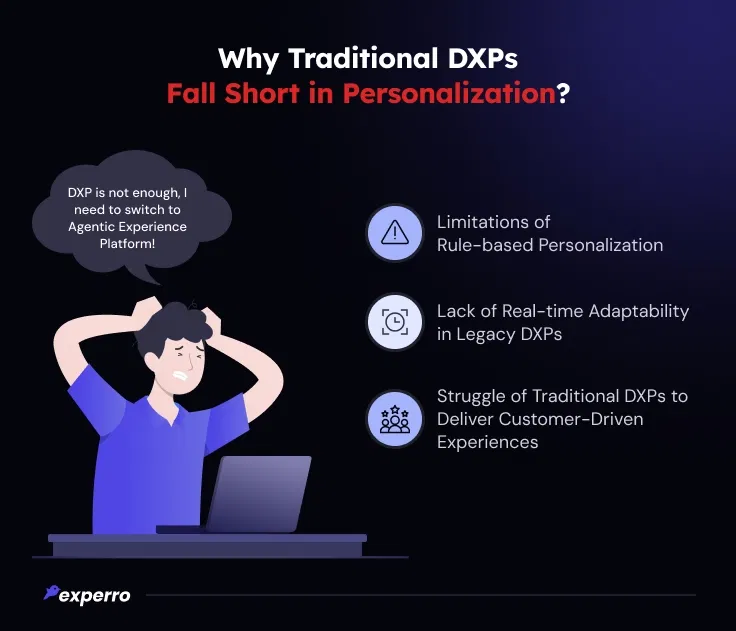
1. Limitations of Rule-Based Personalization
Traditional DXPs rely on predefined rules that apply the same logic to every user. Rule-based personalization lacks the flexibility to adapt to changing behaviors.
For example, a customer browsing diamond rings may receive the same recommendations even after shifting interest to bracelets.
The multi-agent AI experience eliminates this issue by using agentic LLM models to adjust dynamically based on user actions.
2. Lack of Real-Time Adaptability in Legacy DXPs
Legacy systems analyze historical data but fail to adapt in the real-time moment. If a shopper abandons a cart, they won’t receive an immediate and relevant offer.
Implementing agentic AI in customer experience changes this. It adjusts profile-based product suggestions and promotions as users interact—offering a far more fluid experience than traditional CX.
3. Struggle of Traditional DXPs to Deliver AI-Powered, User-Driven Experiences
Consumers now expect eCommerce platforms to understand their intent in real-time. Agentic UX delivers by leveraging AI-powered assistants in CX to anticipate needs and provide meaningful interactions.
This shift marks the rising importance of agentic AI in customer experience, ensuring brands stay ahead in a competitive market.
How Does Agentic Experience Work?
The agentic commerce experience works based on 4 key pillars.
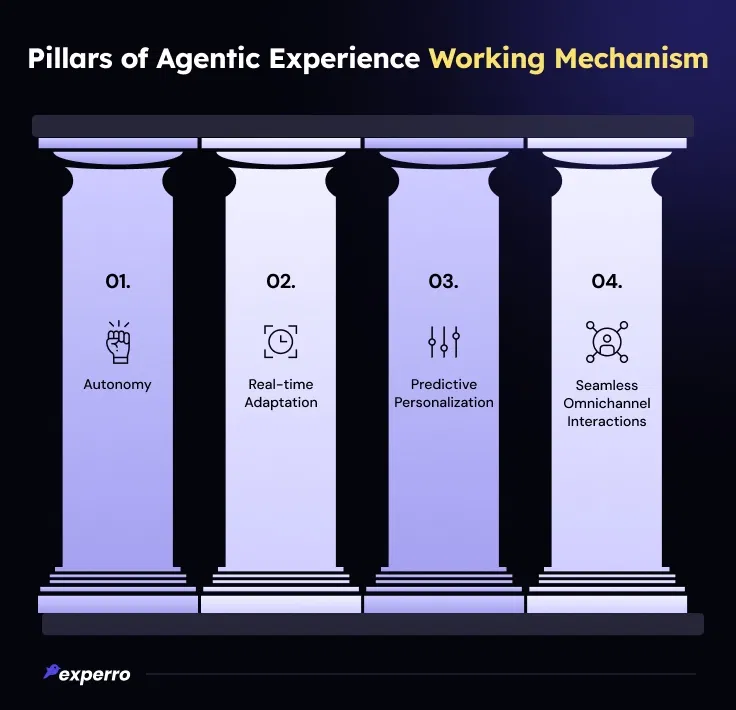
Let’s explore them:
1. Autonomy – Users Have Control Over Their Journeys
An agentic customer experience allows shoppers to explore, refine, and personalize their shopping journey.
Instead of pushing predefined suggestions, an agentic AI user experience lets them filter searches, compare products, and tailor interactions as they go. This self-driven approach enhances engagement and reduces friction.
2. Real-Time Adaptation – AI-Driven Responses to Behavior
Traditional personalization is static. Agentic experience platforms adapt in real time with AI-driven intelligence.
If a shopper browses engagement rings, the system doesn’t just show related products—it detects intent and dynamically curates personalized recommendations, such as matching wedding bands or complementary jewelry styles. This dynamic shift leads to conversion rate optimization.
3. Predictive Personalization – Using Data to Anticipate Needs
Instead of reacting to past behavior, an agentic AI experience anticipates what users will need next.
AI models process data in real time to predict future shopping patterns. This proactive approach ensures shoppers receive context-aware suggestions, enhancing the overall agentic CX.
4. Seamless Omnichannel Interactions – Unified Digital Experience
Consumers interact with brands across multiple touchpoints. A digital agentic experience ensures continuity, whether a customer starts on a website, shifts to mobile, or visits a physical store first.
The best agentic AI for enhancing customer experience creates a consistent, data-driven journey across omnichannel eCommerce.
What Are the Key Benefits of Agentic Experiences in eCommerce?
Adopting an agentic experience transforms customer engagement, personalization, and scalability in eCommerce.
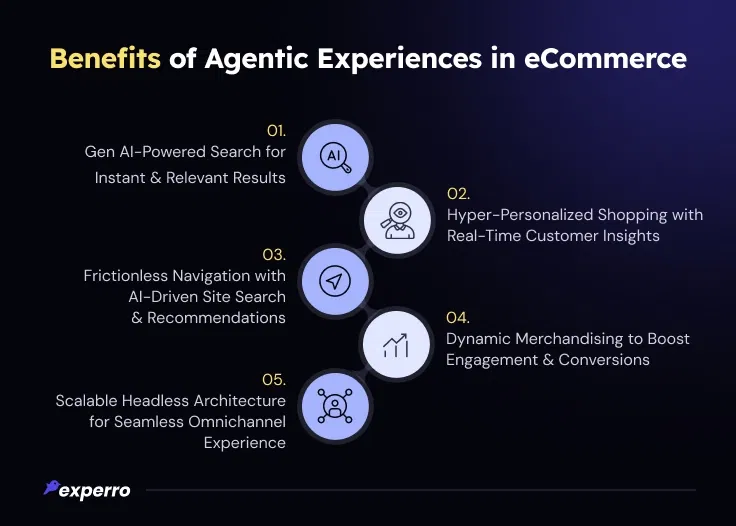
1. Gen AI-Powered Search for Instant & Relevant Results
Agentic Experience Search goes beyond basic keyword matching. Gen AI-powered search engines understand intent, context, and preferences, delivering instant, hyper-relevant results.
This eliminates frustrating search experiences, increasing conversions.
2. Hyper-Personalized Shopping with Real-Time Customer Insights
Instead of relying on static customer profiles, an agentic eCommerce experience enables hyper-personalization by dynamically adapting to real-time user interactions.
Every click, scroll, and interaction refines product recommendations, creating a tailored, data-driven shopping journey.
3. Frictionless Navigation with AI-Driven Site Search & Recommendations
Shoppers shouldn’t have to dig through endless pages to find their needs. Agentic AI UX enables gen AI-driven recommendations that surface the right products instantly.
The result? Faster decisions, better engagement, and lower bounce rates.
4. Dynamic Merchandising to Boost Engagement & Conversions
An agentic AI customer experience reshapes digital merchandising by dynamically adjusting product displays, promotions, and recommendations based on live behavior.
This AI-driven strategy boosts user engagement and maximizes sales potential.
5. Scalable Headless Architecture for Seamless Omnichannel Experience
A headless architecture enables brands to deliver consistent personalization at scale across all digital channels.
By decoupling the frontend and backend, it ensures seamless integration of AI-powered experiences across mobile, web, and in-store interactions—creating a unified and engaging customer journey.
Now that we've explored the benefits of agentic experiences, let’s look at the best practices for implementing them effectively.
What Are the Best Practices for Implementing an Agentic Commerce Approach?
Implementing an agentic experience requires a strategic blend of AI, automation, and personalization. Businesses must focus on seamless integrations and real-time adaptability to create user-driven experiences.

Let’s check out some best practices for adopting an agentic approach:
1. Leverage AI-Driven Search for Smarter Product Discovery
An Agentic Experience search enables customers to find products faster through AI-powered search capabilities.
AI analyzes user behavior, past interactions, and real-time queries to deliver hyper-relevant results. This enhances product search and discovery and increases conversions.
2. Utilize Real-Time Data for Personalized Shopping Journeys
Basics of agentic AI customer experience rely on real-time data to tailor experiences based on user actions.
AI dynamically adjusts product recommendations, promotions, and content to match customer preferences. This level of agentic eCommerce experience personalization leads to higher engagement and sales.
3. Ensure Seamless Integration with a Headless & Composable Setup
A digital agentic experience thrives on a flexible architecture. A headless and composable approach allows businesses to integrate generative AI-driven personalization across various touchpoints without disrupting the existing ecosystem.
This ensures smooth, scalable operations.
4. Optimize Merchandising with AI-Powered Insights & Automation
Agentic AI in customer experience helps transform personalized merchandising strategies. AI-driven insights help businesses identify trends, predict demand, and automate product placements.
This boosts engagement and ensures customers see the most relevant products at the right time.
5. Blend AI & Human Oversight for Customer-Centric Interactions
While AI enhances agentic CX, minimal human intervention oversight ensures the accuracy and relevance of personalization.
AI-powered search autocomplete should work alongside human expertise to create a customer experience agentic AI model that balances efficiency with emotional intelligence.
Next, let’s explore the challenges businesses may face when adopting an agentic experience.
What Are the Challenges in Adopting an Agentic Approach?
Adopting an agentic AI experience comes with challenges, particularly in managing AI-driven processes and maintaining customer trust.
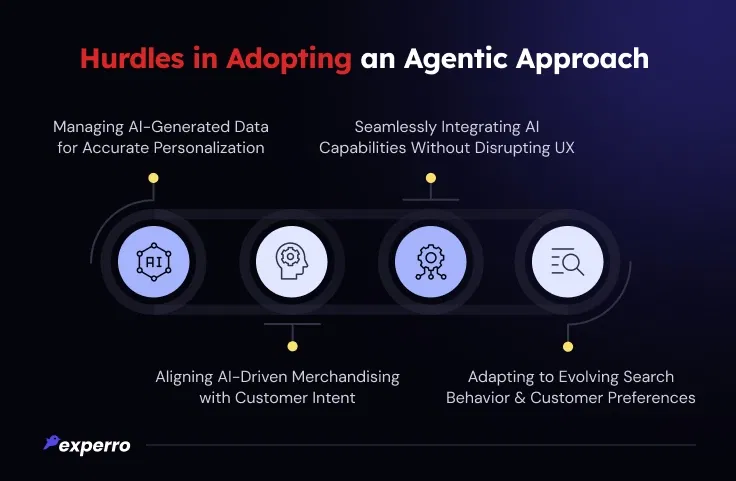
Businesses must address these complex challenges to unlock the full potential of Agentic Experience in eCommerce.
1. Managing AI-Generated Data for Accurate Personalization
AI processes vast amounts of customer data. Ensuring the accuracy of data is crucial for agentic experience driven personalization.
Your business must implement strict data governance policies to maintain high-quality insights and prevent misleading recommendations.
To overcome this, Experro ensures precise data handling with AI-powered eCommerce analytics and real-time insights, delivering accurate and relevant personalization.
2. Aligning AI-Driven Merchandising with Customer Intent
AI-driven merchandising must reflect customer needs, not just business goals.
Agentic AI capabilities help align product placements with real-time shopping behavior, but businesses need constant refinement to avoid irrelevant or forced recommendations.
However, Experro’s dynamic searchandising uses behavioral data and AI-driven automation to align product displays with real-time customer intent, enhancing engagement.
3. Seamlessly Integrating AI Capabilities Without Disrupting UX
Integrating agentic experience technology into existing platforms can be complex. A smooth transition requires a modular approach where AI enhancements complement rather than replace traditional systems.
To simplify integration, Experro’s headless and composable architecture allows seamless AI adoption without disrupting the existing UX, ensuring a smooth transition.
4. Adapting to Evolving Search Behavior & Customer Preferences
Customer search behavior is constantly evolving. AI agents in CX must continuously learn and adapt to new trends, language variations, and intent-driven queries. Without this adaptability, search relevance and personalization may decline over time.
To stay ahead, Experro’s AI-powered search continuously learns from user interactions, adapting to changing behaviors and preferences for more accurate and personalized search results.
By addressing these challenges, businesses can fully leverage agentic AI to enhance customer engagement, personalization, and overall eCommerce efficiency.
Now, let’s clear up common misconceptions about Agentic Experience and how it differs from traditional systems.
What Sets Agentic AI Apart - Agentic vs. Everything Else
Many believe that Agentic Experience is just another term for DXP or that Agentic AI functions like traditional AI. However, these assumptions are misleading.
Agentic systems fundamentally differ, offering dynamic, autonomous decision-making instead of predefined rules.
Let’s break down the key differences.
1. Agentic Experience vs DXP
| Point of Difference | Agentic Experience | DXP |
|---|---|---|
| Decision-making | Autonomous, adapts in real time | Predefined rules and workflows |
| Personalization | Context-aware, proactive recommendations | Rule-based personalization |
| User Control | Empowers users with dynamic experiences | Provides structured user journeys |
| Flexibility | Adapts based on interactions | Requires manual configuration |
| Which is Better? | Hands down, Agentic Experience is the best! Effortlessly scales by learning from users | Requires ongoing configuration to scale |
2. Agentic AI vs Traditional AI
| Point of Difference | Agentic AI | Traditional AI |
|---|---|---|
| Autonomy | Makes decisions independently | Requires predefined instructions |
| Learning | Self-improving based on interactions | Trained on static datasets |
| User Interaction | Proactive and contextual | Reactive and rule-based |
| Use Cases | Personalized experiences, decision-making | Data analysis, automation |
| Which Is Smarter? | Smarter! It continuously adapts and evolves | Limited to pre-trained knowledge |
3. Agentic Experience vs Traditional CX
| Point of Difference | Agentic Experience | Traditional CX |
|---|---|---|
| Customer Journey | Adapts in real time | Predefined touchpoints |
| Engagement | Personalized and proactive | Generic and reactive |
| Decision Making | AI-driven, contextual responses | Manual optimizations |
| Scalability | Easily adapts to user behavior | Limited adaptability |
4. Agentic AI vs Generative AI
| Point of Difference | Agentic AI | Generative AI |
|---|---|---|
| Definition | AI that autonomously takes actions, adapts to goals, and interacts dynamically with environments | AI that generates content like text, images, or code based on input prompts |
| Primary Purpose | Decision-making, problem-solving, and task execution | Content creation, image generation, and text-based outputs |
| Autonomy Level | High—acts independently based on objectives and context | Low—relies on user prompts to generate responses |
| Adaptability | Continuously learns and modifies behavior in real time | Generates outputs based on pre-trained data but lacks real-time adaptation |
| User Interaction | Engages dynamically, takes proactive steps, and adjusts strategies | Responds to queries or commands without taking independent actions |
| Examples | AI-powered assistants, self-driving systems, autonomous agents | Chatbots, AI art generators, content-writing models |
| Data Utilization | Processes and applies data usage for decision-making and real-world actions | Uses existing datasets to create new but similar outputs |
| Scope of Use | Ideal for automation, problem-solving, and autonomous decision-making | Best for creative fields, content generation, and media production |
Both Agentic AI and Generative AI serve distinct purposes in the AI landscape.
While Agentic AI focuses on autonomous decision-making and real-time adaptability, Generative AI in eCommerce platforms excels in producing creative outputs based on user input.
Understanding their differences helps businesses and developers choose the right AI model for their specific needs, whether for automation, problem-solving, or content creation.
How Experro Empowers eCommerce with Agentic Experiences?

Experro provides a cutting-edge Agentic Experience Platform designed for eCommerce brands that prioritize personalization and search accuracy.
With agentic AI capabilities, Experro enables:
- AI-powered search that understands user intent and delivers instant results.
- Hyper-personalized experiences that adapt to real-time customer behavior.
- AI-driven eCommerce merchandising for dynamic product placements.
- Frictionless navigation with AI-powered product recommendations.
The future of agentic experience lies in platforms like Experro that offer businesses the tools to provide the best agentic AI for enhancing customer experience.
Conclusion
An agentic workforce shifts digital interactions from rule-based personalization to real-time adaptability.
AI-powered search, predictive personalization, and seamless UX create a future-proof customer journey.
Your business has the opportunity to lead in engagement, conversions, and customer satisfaction by embracing agentic AI in customer experience.
Want to transform your eCommerce experience? Schedule a call with our experts for a personalized demo of Experro's Agentic Experience Platform.
FAQs


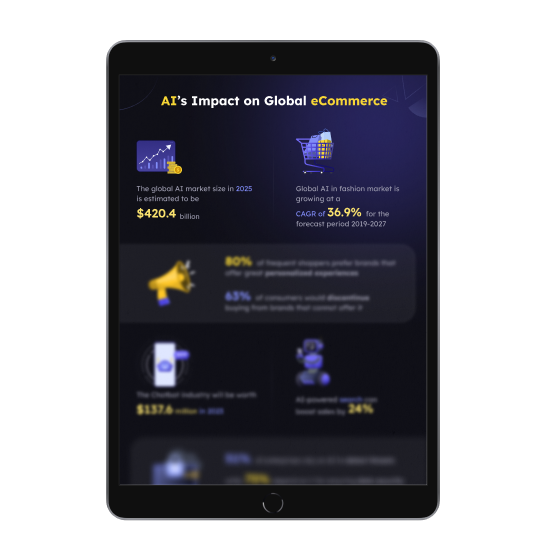
Pallavi Dadhich
25 March 2025Pallavi is an ambitious author known for her expertise in crafting compelling content across various domains. Beyond her professional pursuits, Pallavi is deeply passionate about continuous learning, often immersing herself in the latest industry trends. When not weaving words, she dedicates her time to mastering graphic design.